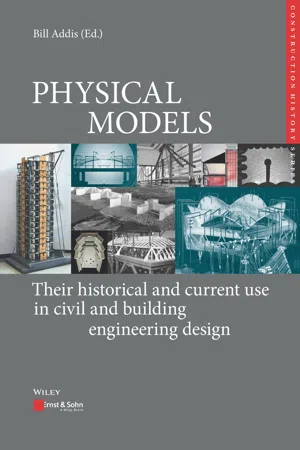
Physical Models
Their Historical and Current Use in Civil and Building Engineering Design
- English
- PDF
- Available on iOS & Android
Physical Models
Their Historical and Current Use in Civil and Building Engineering Design
About this book
Physical models have been, and continue to be used by engineers when faced with unprecedented challenges, when engineering science has been non-existent or inadequate, and in any other situation when the engineer has needed to raise their confidence in a design proposal to a sufficient level to begin construction. For this reason, models have mostly been used by designers and constructors of highly innovative projects, when previous experience has not been available.
The book covers the history of using of physical models in the design and development of civil and building engineering projects including bridges in the mid-18th century, William Fairbairn?s Britannia bridge in the 1840s, the masonry Aswan Dam in the 1890s, concrete dams in the 1920s, thin concrete shell roofs and the dynamic behaviour of tall buildings in earthquakes from the 1930s, tidal flow in estuaries and the acoustics of concert halls from the 1950s, and cable-net and membrane structures in the 1960s.
Traditionally, progress in engineering has been attributed to the creation and use of engineering science, the understanding materials properties and the development of new construction methods. The book argues that the use of reduced scale models have played an equally important part in the development of civil and building engineering. However, like the history of engineering design itself, this crucial contribution has not been widely reported or celebrated.
The book concludes with reviews of the current use of physical models alongside computer models, for example, in boundary layer wind tunnels, room acoustics, seismic engineering, hydrology, and air flow in buildings.
Frequently asked questions
- Essential is ideal for learners and professionals who enjoy exploring a wide range of subjects. Access the Essential Library with 800,000+ trusted titles and best-sellers across business, personal growth, and the humanities. Includes unlimited reading time and Standard Read Aloud voice.
- Complete: Perfect for advanced learners and researchers needing full, unrestricted access. Unlock 1.4M+ books across hundreds of subjects, including academic and specialized titles. The Complete Plan also includes advanced features like Premium Read Aloud and Research Assistant.
Please note we cannot support devices running on iOS 13 and Android 7 or earlier. Learn more about using the app.
Information
Table of contents
- Cover
- Title Page
- Copyright
- Foreword of the series editors
- Foreword
- Preface
- Contents
- Section A Physical models from ancient times to the 1880s
- Section B Physical models used in structural design, 1890s‐1930s
- Section C Physical models used in structural design, 1940s to 1980s
- Section D Physical models used in non‐structural engineering disciplines
- Section E Physical modelling in the twenty‐first century
- Appendices
- Appendix A.1 Extract from Vitruvius (c.30-15 BC)
- Appendix A.2 Extract from Galileo (1638)
- Appendix A.3 Leonhard Euler (1766) A simple rule to determine the strength of a bridge or similar structure, on the basis of the known strength of a model
- Appendix A.4 Extract from report: Telford’s design for new London Bridge (1801)
- Appendix A.5 Experimental Models, The Builder (1846)
- Appendix A.6 On model experiments, The Civil Engineer and Architect’s Journal (1847)
- Appendix A.7 Osborne Reynolds (1888) Extract from paper: On certain laws relating to the regime of rivers and estuaries
- Author biographies
- About the series editors
- About this series
- Index
- EULA